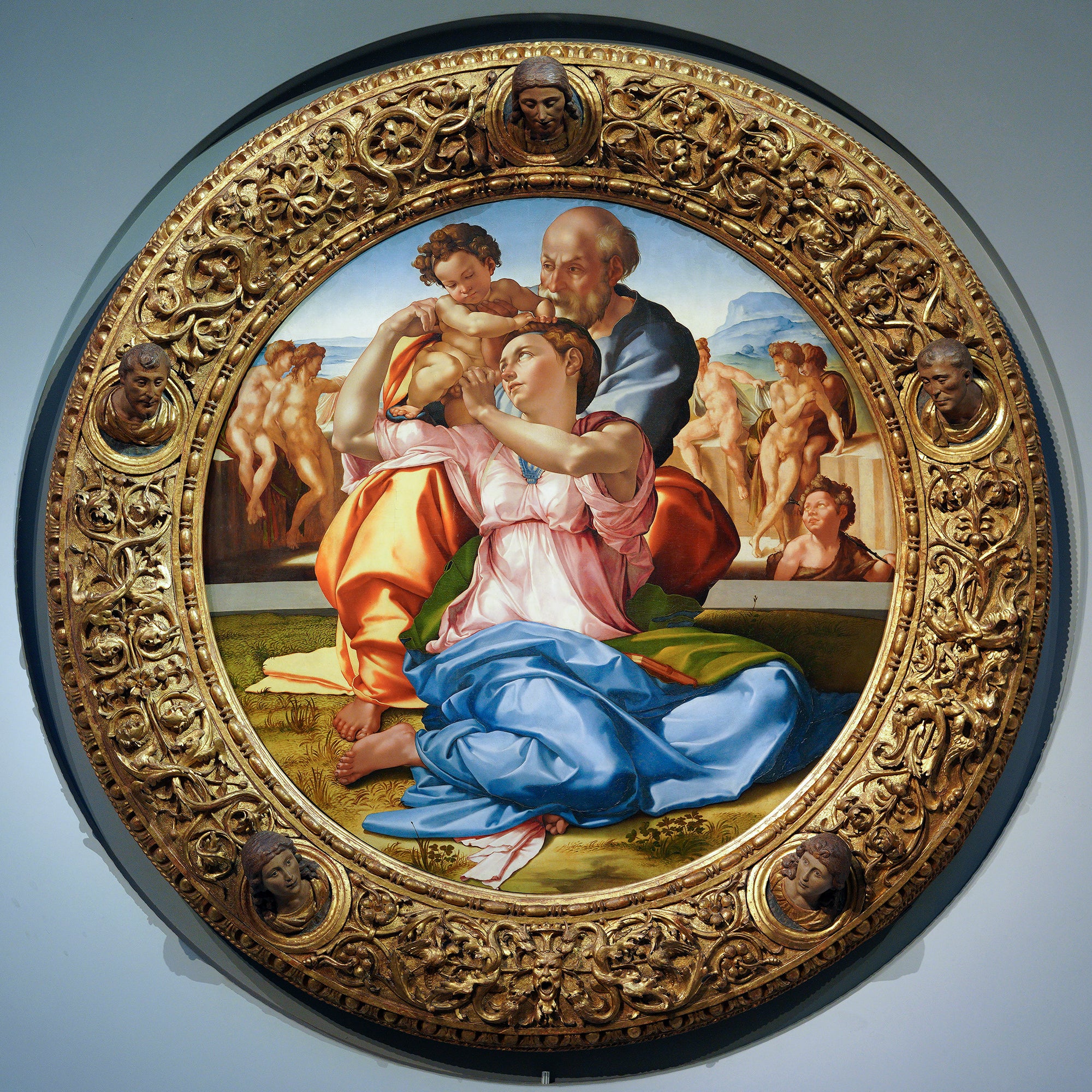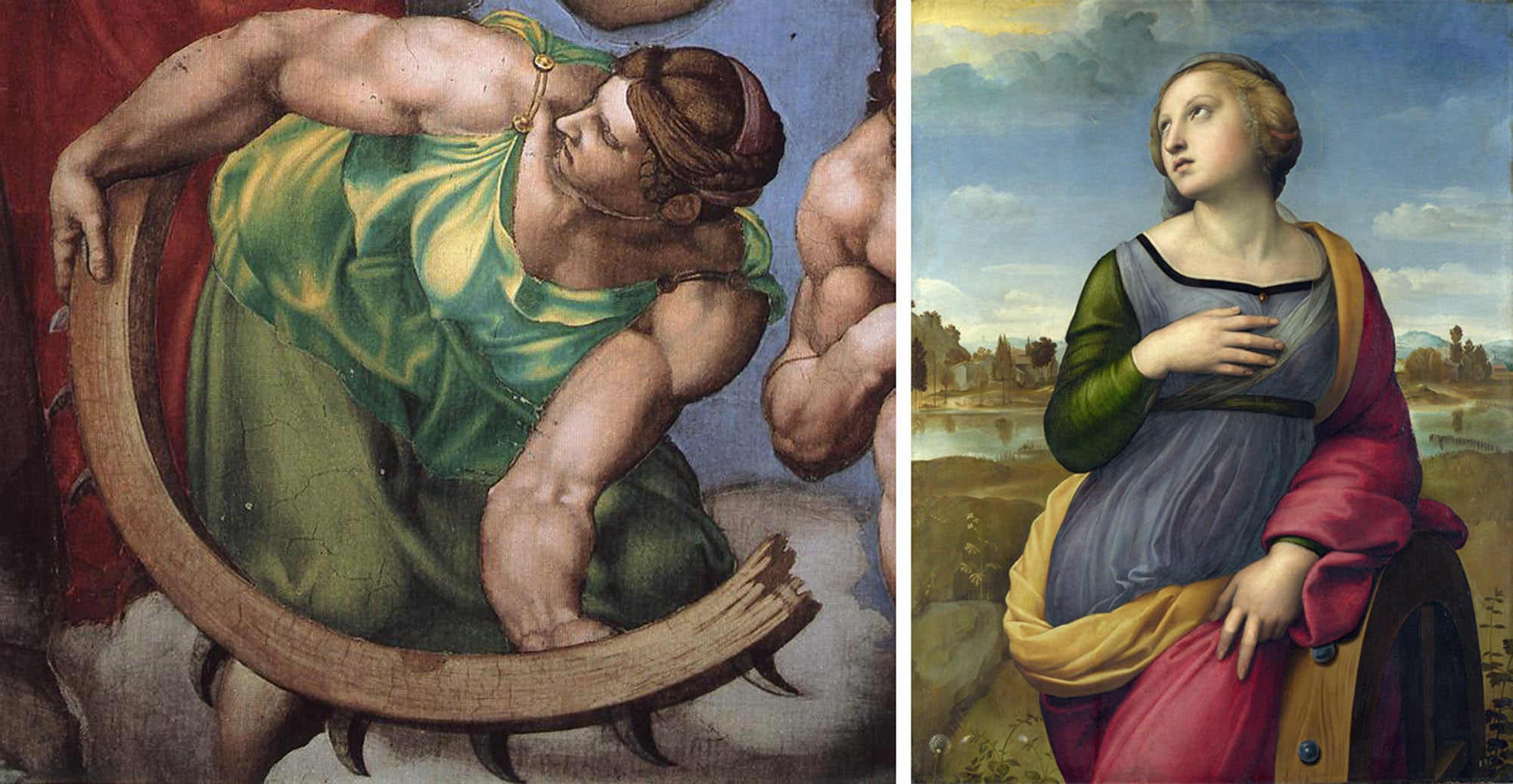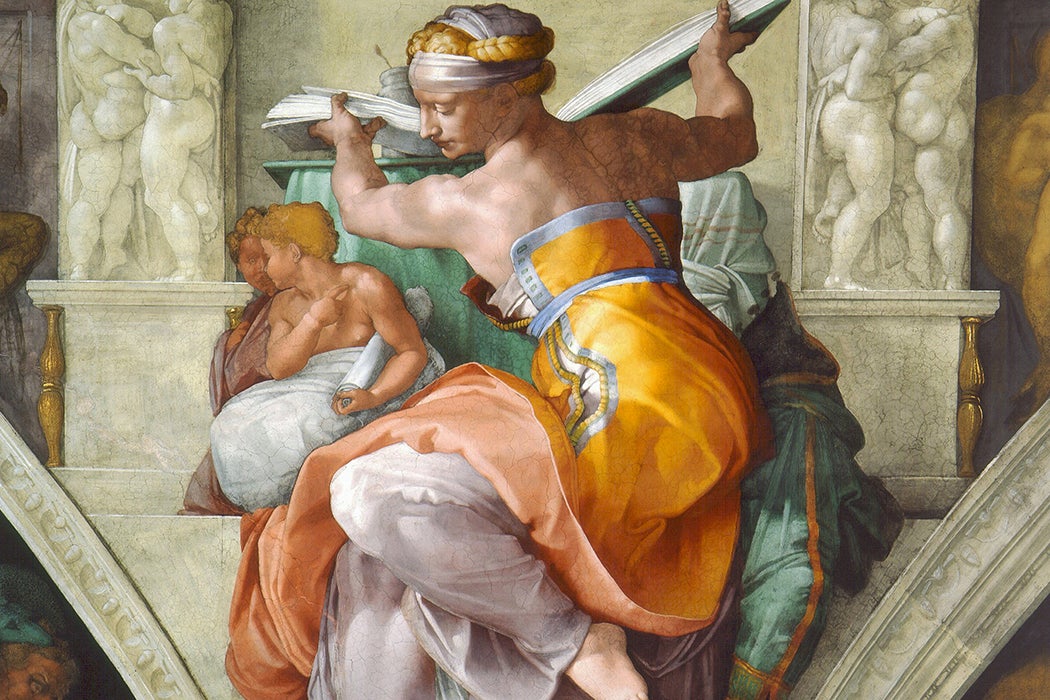It’s difficult to describe Michelangelo’s version of The Libyan Sibyl on the ceiling of the Sistine Chapel. Before Michelangelo painted her, the prophetess was known in legend as an ancient seer. Given her gift, Christians at the time assumed that she and other sibyls must have known of Christ’s coming birth. Thus, five female oracles join the pantheon of Old Testament prophets in Michelangelo’s masterpiece.
Dressed in a metallic yellow dress, she picks up an enormous tome. Upon first glance, a viewer might briefly wonder if the figure depicted is a woman or a man. Untether such confusion; this rendering is—in a sense—of both.
In 1925, artist Bryson Burroughs analyzed Michelangelo’s draft drawings for the Sibyl and noted that the artist used a male model in depictions of her mostly unclothed body. On one side of the paper is a male figure with a hyper-muscular backside, the sort that might be expected in a portrayal of Hercules. But there’s empty space where the figure’s hair should be, as “nothing would have been gained by drawing the hair of this model in a study which was to serve for a female figure.” The reverse of the same sheet shows a pair of female legs. The final fresco is a sort of male-female chimera, something that Burroughs calls “beyond sex—beyond mankind.”
While The Libyan Sibyl is a popular example of this phenomenon, Michelangelo built a minor reputation for using male models to depict women in a manner that art historian Jill Burke has likened to “men with breasts.” In his Doni Tondo, the Virgin Mary’s biceps bulge as she lifts baby Jesus into the air, and the breasts on the sculpture Night look like a misshapen afterthought.

It would have been scandalous for many women in Renaissance Italy to pose nude, but many scholars argue that these mores fail to offer sufficient explanation for the ongoing androgyny in Michelangelo’s oeuvre. Raphael and contemporaneous masters similarly used male models as the basis for many female figures, yet, as Raphael’s St. Catherine of Alexandria demonstrates, the artist nevertheless drew a classically feminine portrayal (compare Raphael’s work to Michelangelo’s depiction of the saint).
Pockets of Michelangelo’s artwork show that not all of his women possessed overt male qualities. He drew a female nude in preparation for his painting of the Entombment, and one need look no further than his sculpture of the Pietà to be persuaded that he could depict a woman with feminine attributes very convincingly. Instead of being for the sake of propriety or tradition, Michelangelo likely used male models and created masculine depictions intentionally.
Weekly Newsletter
Historian Domenico Laurenza calls Michelangelo an “artist-anatomist” in his exploration of both fields in Renaissance Italy. Indeed, the lines between art and anatomy blurred in the sixteenth century; both disciplines relied on each other to accurately describe what lay under the skin of a human body. Florentine officials even authorized the release of corpses for dissection to both physicians and artists alike. Michelangelo performed private dissections of his own, developing a signature artistic focus on the skeletal system and musculature. Leonardo da Vinci criticized this focus, saying that the practice resulted in “a sack of walnuts rather than the human form.” That said, Leonardo undertook his own dissections; they led him to make the pioneering discovery that the heart has four chambers.

In exploring Michelangelo’s study for The Libyan Sibyl, Laurenza notes the care and detail the artist put into creating an accurate deliberately male back. Michelangelo marks where the clavicle fits into the shoulders with a self-defined symbol that looks like a pushpin. He etches other marks that must have meant something in his personal lexicon, as they recur in his other artistic and anatomical drawings. Michelangelo’s symbols “appear to lend the drawings a more scientific air, as they recall the symbolic lines or letters on anatomical illustrations made for a specialized audience,” writes Laurenza. “Because they are clearly not part of a formal system for indicating muscles, these marks are an integral component of the strictly anatomical-artistic syntax to which, in Michelangelo’s hands, anatomy belonged.”
If Michelangelo intentionally used female characters to explore male anatomy, the next question is why?
Historian Yael Even explores this question with Renaissance-era patriarchy in mind. First, she considers the possibility that Michelangelo preferred male bodies over female ones because he found them more beautiful. While some scholars suggest this could be a reflection of the artist’s sexuality, it could also be a reflection of the time—women were commonly considered physiologically inferior to the “perfect” male form. The preference could also be because a lot of Michelangelo’s work was created for a completely-male audience. The Libyan Sibyl, for example, was created for the Sistine Chapel, a site of papal activity.
Even also considers the possibility that Michelangelo inherently associated masculinity with power. She notes that Michelangelo referred to a female friend in the male gender. Vittoria Colonna, the Marchesa of Pescara, lived as a poet and intellect after her husband’s death, which “was regarded in the Renaissance as the life of a man.” At a time when formal power was held by men, Michelangelo might have used the male gender as a way of emphasizing Colonna’s unusual agency.
The use of masculinity to connote power goes further back in art history than the Renaissance. Athena offers an example from the ancient world. The Goddess of war and wisdom is seldom depicted in the same sensuous style as her sister Aphrodite, the Goddess of love and fertility. In mythology, Athena is often shown as a rational mentor to male heroes like Odysseus and Telemachus. However, Athena’s associations with her own sex are limited; she has no mother and bears no children. The suppression of her feminine characteristics in myth and in art is ultimately what solidifies her standing as a woman who can be taken more seriously among men.
Michelangelo follows this ancient tradition as the wise Libyan Sibyl, with the receipt of a powerful revelation from God, “joins the rank of her ‘fellow’ [male] prophets and disavows any association with her proper gender,” writes Even. “At the same time, when viewed from the vantage point of Michelangelo, who glorified man’s grandeur, this penalty can be considered a rare, albeit circuitous, tribute.”
A second (not mutually exclusive) possibility for Michelangelo’s practice was the growing popularity of androgynous depictions in circles of Renaissance Italy. After all, this was the era when humanist Mario Equicola wrote that, “the effeminate male and the manly female are graceful in almost every aspect.” Just as Michelangelo gave some of his women bulging muscles, other artists gave men younger, more effeminate faces and hips. Leonardo’s Saint John the Baptist, with his long hair and smooth skin, is described as “a beautiful youth of feminine delicacy.” Likewise, in Donatello’s David, the shepherd-turned-giant-slayer wears a victor’s crown that resembles a bridal wreath. Art historian Maya Corry argues that androgyny’s popularity in some circles was in part due to the era’s obsession with harmony between disparate elements, such as the balance of the four humors in the body or the balance of a figure’s body weight in the contrapposto pose.
In addition, androgynous figures bear a more religious, devotional undertone. Angels are unsexed in Christian thought. Thus, literally mixing a figure’s masculine and feminine qualities as a way of bringing the figure, whether a sibyl with divine revelation or a martyred saint of antiquity, closer to heaven and God.
The scholarly debate over whether Michelangelo’s women elevate the androgynous figure or denigrate the feminine one (or both) remains timely as politicians and activists argue anew over gender, beauty standards, and the role of women in society.
In 2019, artist Clio Newton’s Venus collection went on view at the Forum Gallery in New York. Inspired by Michelangelo and other Renaissance artists, Newton created a collection of charcoal drawings of modern-day female heads on male torsos. In the catalogue for this exhibition, art critic Eleanor Heartney called this selection of paintings uncanny, noting that “the moment of transition is imperceptible—in some works, it appears to happen around the shoulders or neck, in others, we only become aware of the shift in genders in the arms and legs.” Despite this, Heartney points to how the figures also take on a comforting tone in the midst of modern debates about sex and gender. “In today’s climate,” Heartney says, “their willingness to simply be themselves offers a bracing tonic.”
Editor’s note: This article was amended to clarify that protections for trans people do not come at the expense of those for cisgender women, and that trans women are women.







